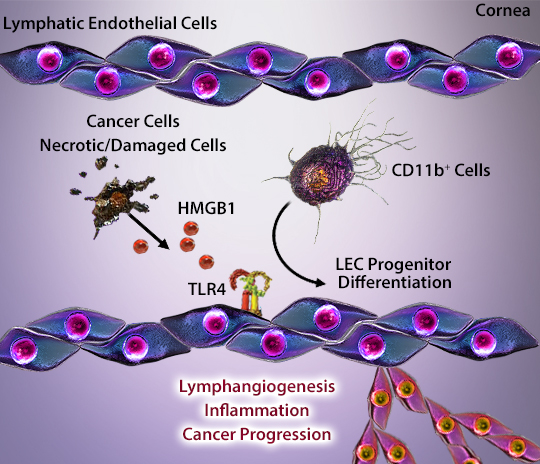 |
| Lymphangiogenesis is the formation of new lymphatic vessels. This process can be triggered by inflammation. HMGB1 can be an inflammatory factor released by cancer cells, immune cells, and damaged/necrotic cells. HMGB1 can bind to TLR4 to generate pro-lymphangiogensis cytokines (like VEGF), increase sensitivity to these factors, and can cause the release of chemokines that draw in CD11b+ cells. These infiltrating cells can then become Lymphatic Endothelial Cell (LEC) progenitors. Together, these factors can promote inflammation-induced lymphangiogenesis and metastasis of cancerous cells. As such, the study of the various components of this mechanism are extremely important, and BioLegend provides a diverse range of reagents for the studies of these individual components. |
 |
| Adapted from Han, L. et al. 2016. PLoS One. 11:e0154187. Pubmed |
 |
| Recombinant Human HMGB1 Recombinant Mouse HMGB1 Anti-Human/Mouse HMGB1 Antibodies |
 |
| Human Antibodies: | Recombinant Proteins: |
|---|---|
| β-actin CD11b MMP2 PCNA NFκB TLR4 VEGFR3 |
Human MMPs Human VEGF Mouse MMPs Mouse VEGF |
| Mouse Antibodies: | ELISAs: | |
|---|---|---|
| β-actin CD11b F4/80 NFκB PCNA TLR4 VEGFR3 |
Human IL-1β Human MMPs Human TNF-α Mouse IL-1β Mouse TNF-α |
|
| LEGENDplex™ | ||
|---|---|---|
| Human Macrophage/Microglia Panels Human Growth Factor Panel NHP Growth Factor Panels |
||
| To learn about our chemokines and other recombinant proteins, check our brochure. For Functional Antibodies, check out our LEAF™, Ultra-LEAF™, and GoInVivo™ products. |
*Any references to promotions on this page may not be valid at this time. View our promotions page for the most up-to-date promotions.
 Login/Register
Login/Register 






Follow Us